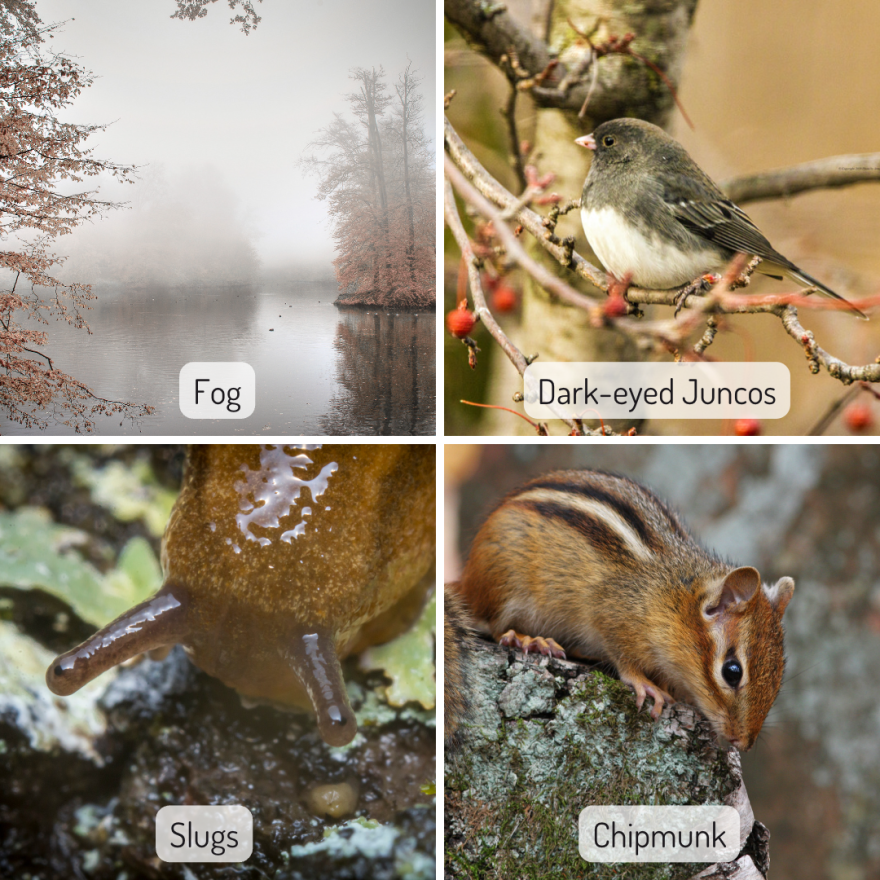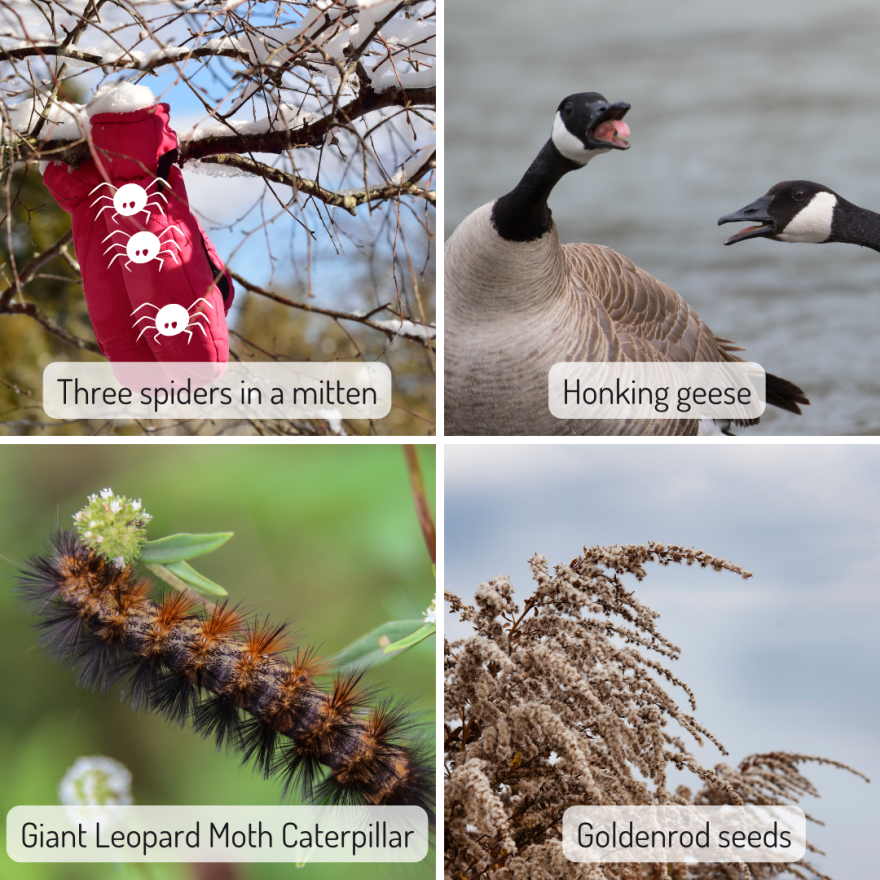In this week's phenology reports, John gets tricked by a kid's Halloween costume, swans populate the state's lakes and rivers, and three spiders find a home in an abandoned mitten!
Adeline reports from Nathan Lindner's class at Cohasset Elementary School. The trees, including the cottonwoods and white aspens, have dropped all their leaves. They found canary reeds in the field and an aster flower, which gets its name from looking like a star (aster is the Latin word for "star"). A partially-frosted field gave the class a chance to learn about aspect, or the direction a slope faces. Southern-facing slopes see more direct sunlight and melt quickly, while northern-facing slopes retain frost and snow later in the day or season. "It's all about positioning!" They also discussed how seeds disperse, mentioning "ploppers, droppers, fliers, hitchhikers, and (best of all) poopers." While walking, they saw a mouse, some spiders, and ducks flying south. They're looking forward to the first snowfall and ice forming on the lakes! "Onward and awkward!"
John thanks Adeline for the report and reiterates some of the observations. He mentions that the asters' seeds are 'fliers': you can whack their seedheads, and a number of the seeds will fly off in the breeze! He was grateful for the frosty morning, which provided an excellent example of the influence of aspect on temperature.
Natalie and Destiny report from Matt Alleva's class at Hill City School. The trees on their phenology trail are entirely bare, and the Red Osier Dogwood's bark is a deep scarlet red. In the area, students observed a bobcat that had recently eaten a squirrel, a few foxes, a black bear with a cinnamon tint to its fur, swans migrating, twenty turkeys, and an overly friendly squirrel. They've also been seeing signs of wolves and hearing their howls! "It's a bird, it's a bee, it's phenology!"
John thanks Natalie and Destiny for their report and says, "If you think the [bark of the Red Osier Dogwood] is red now, wait until February or March! It's gonna just blow your socks off." He mentions that most bears have gone into hibernation by now, but a few hunters see one every year. It likely got disturbed, but possibly, it has yet to go to sleep. Bears generally hibernate beginning in mid-September, and most have bedded down by the first week of November. Swans migrating through are covering waterways: John saw 50 on the Mississippi last week. They will move as far south as they need to find open water and food, then remain there through the winter.

Donnie reports from Leigh Jackson's class at North Shore Community School in Duluth. November is the month of deer and the ice-forming moon. On November 2nd, it hit 70 degrees in Duluth Township! It was an unseasonably warm week: at this time last year, snow was already on the ground! Thanks to the warm weather, the grass was turning green again, and the deer were foraging through yards. The trees were bare in the school forest, and the cattail fluff was beginning to float on the wind. As deer season is here, the students reminded us to be safe in the woods and to wear bright colors. The creatures the class observed this week included owls, juncos, redpolls, Blue Jays, Hairy Woodpeckers, Downy Woodpeckers, Pileated Woodpeckers, pheasants, partridges, and turkeys. Despite a few nights with below-freezing temperatures, there were still insects flying around: they, too, enjoyed the warm weather! "Have a great week, and be observant!"
John thanks Donnie for the report and appreciates their comparison to last year's temperatures. He also notes that the cattails near his house are beginning to puff open and distribute their seeds.

Rohan and Ashlynn report from Steve Dahlberg's class at the Holy Rosary School in Detroit Lakes. Their class saw large flocks of Red-winged Blackbirds, ten swans in a field, three bucks sharing a yard with a rabbit, the waxing moon shining through the clouds, and a Blue Jay eating bird seed from a feeder. They also saw a variety of high-speed chases: two Bluejays chasing each other, a bunch of first-graders in pursuit of a grey squirrel, and two grey squirrels chasing each other around. One student "observed a painted turtle trick-or-treating at her front door." In addition, a squirrel attempted to break into a bird feeder, a group of birds fought over food in a cornfield, a snake hid in a garage, and a white poplar tree still had green leaves. "Have a great week!"
John thanks Rohan and Ashlynn for their report and mentions that he used to see huge flocks of Red-winged Blackbirds when he went duck hunting. Now that he's stopped hunting ducks, he's been missing seeing the Red-winged Blackbirds! John has seen vast flocks of them in the western and southern regions of the state. Once, in the aptly-named town of Red Wing, he saw a steady stream of blackbirds passing by for over an hour. Next, John mentions that he was surprised to hear about the turtle at a student's front door; "It's getting late for turtles. They're going to looking for their places of rest."
Heidi points out, "It was a painted turtle on Halloween."
John, thinking it through, says, "You think it was not actually a live sort of turtle? It wasn't a turtle that wandered up on the deck? It was a costume?"
Heidi: "I think so. They said 'trick or treating.' They got you!"
John responds, "They did! <laugh> I've lived in the same house for 43 years and I've had only one Halloween visitor, so I'm a little unfamiliar with Halloween these days." [Good one, Holy Rosary students! I got a good chuckle out of that.] Nevertheless, John says he found a garter snake this week, so some real-life reptiles are still out and about.

Bethy, Lucy, and Vivian report from Deanne Trottier's class at Eagle View Elementary in Pequot Lakes. Thursday, November 3rd, started bright and sunny, but the temperature dropped, the wind came up, and it was really foggy. More typical weather soon returned, with ice forming on the puddles and flocks of crows and juncos flying around. The juncos were feeding on berries, and chickadees were frequenting the bird feeders. The students have seen flocks of trumpeter swans, slugs in the gardens, squirrels (red, grey, and black!), and a chipmunk. They also found a spot where a deer had rooted around in the leaves, looking for acorns. Most of the trees are bare, but some brown leaves are still on the oak trees. "This is Bethy, Lucy, and Vivian reporting from Pequot Lakes!"
John thanks them for the report, reiterates some of their observations, and mentions chipmunks have been absent the past few days from his place! He's keeping an eye out, as this is when they'll disappear from view as they go into hibernation. Finally, he concurs that red oaks are one of the few trees that retain their leaves this late in the year. [Welcome back, Eagle View Elementary! It's great
to hear from you!]

Eli reports from Albertville West's trip to Long Lake Conservation Center:
"During our trip to Long Lake Conservation Center this week, we saw trumpeter swans on Long Lake along with a pair of Canada Geese. The geese were honking loudly as they landed on the lake, then they swam around a bit still honking very loudly and then they took off into the sky honking the whole time. In the bog one class found a lost mitten and when they looked inside of it they found 3 large spiders. The mitten was left in the bog since it was being put to good use. Also in the bog, we saw a gray tree frog, little moths, a giant leopard moth caterpillar and the tamarack trees have lost 99.6% of their needles. Other sightings included chipmunks, squirrels, blue jays, juncos, nuthatches and a red-bellied snake. The garter snakes we saw were all near their hibernaculum. We enjoyed helping the aster, goldenrod and milkweed with seed dispersal by giving them little shakes as we walked through the forest. It was a great week in nature and we want to remind everyone to…Unplug, Get outside,
and LIVE CONNECTED!!"
John thanks them for the report and agrees that it's a great time to connect with the world. He loves the idea of walking through the woods, shaking the plants to help the seeds disperse. [I loved the story of the spiders in the mitten!]

Neta, Laura, and Rose report from Leona Cichy's class at Roots and Wings Forest School in New York Mills. The weather started warm, with temperatures over 70 degrees on Wednesday! Thursday was colder, with heavy fog. Friday saw temperatures in the thirties. During the week, students saw Blue Jays, Red Squirrels, deer, and a juvenile Bald Eagle. They also saw swans in the pond and adopted a forest school cat named Raven. The Tamarack trees are losing all of their needles. "Thanks for listening!"
John thanks them for their report and notes that Laura and Rose just turned five years old! "We're getting them an early start in public radio!" He reiterates a few of their observations and adds that the Tamarack trees are getting down to their last few needles.

Ledger and Noah report from Mary Wilfahrt's class at Shakopee West Middle School. They have noted warmer weather than usual, though there has been frost on the ground. Squirrels have been busy gathering nuts, and birds are migrating south. The wind is still causing trouble! "That is what's happening in Shakopee. Science has the solution!"
John agrees that science is the solution and jokes that water and salt is the solution. [Was that a crying joke, or just a generic science joke? I'm not sure.] He reiterates a few of their observations and adds that he loves to hear from students! "Anyone who is looking at phenology is a student of nature, and that's regardless of your age."

On that note, dear reader, get out there and start studying!
Remember that you can add your voice to this list! We would love to hear from you. Get in touch with me (smitchell@kaxe.org) or John (jlatimer@kaxe.org), or text 'phenology' to 218-326-1234.
For more phenology content, subscribe to our Season Watch newsletter!
Funding for this project was provided by the Minnesota Environment and Natural Resources Trust Fund as recommended by the Legislative-Citizen Commission on Minnesota Resources (LCCMR).






